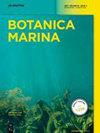基于叶绿体基因组的江蓠科江蓠和江蓠遗传分化
IF 1.4
4区 生物学
Q2 MARINE & FRESHWATER BIOLOGY
引用次数: 1
摘要
摘要江蓠科植物在生物技术工业和微生物学研究中具有重要意义。一些黄豆属植物在形态上难以鉴定,分子系统发育数据在物种水平鉴定中起着关键作用。本研究对马来西亚半岛红藻changii和salicornia的叶绿体基因组进行了测序,并与已发表的分类群进行了比较,以期更好地了解关于红藻,特别是changii和G. firma的系统发育问题。对66个质体基因的系统发育分析表明,马来西亚樟氏菌与樟氏菌形成姐妹系,遗传距离为0.43%。然而,马来西亚和菲律宾樟宜鼠的遗传距离为p = 4.32%,表明它们在遗传上是不同的。5个叶绿体基因(petF、rps12、rps14、rpl18和petB)在马来西亚长叶藻和雪梨间的遗传距离差异较大(p = 1.23 ~ 2.00%),在马来西亚半岛和夏威夷的盐角藻种内遗传距离差异在p = 0 ~ 0.31%之间。马来西亚樟子树种内遗传距离与樟子树种间遗传距离缺乏重叠。firma表明G. changii和G. firma不相同。本文章由计算机程序翻译,如有差异,请以英文原文为准。
Genetic differentiation of Gracilaria changii and Gracilaria firma (Gracilariaceae, Rhodophyta) based on chloroplast genome
Abstract The Gracilariaceae are important in the biotechnology industry and microbiology research. Some Gracilaria species are difficult to identify morphologically and molecular phylogenetic data hold a key role in species level identification. In this study, the chloroplast genomes of G. changii and G. salicornia from the Peninsular Malaysia were sequenced to compare with the published taxa in order to gain a better understanding of the phylogenetic questions regarding the red algae, particularly G. changii and G. firma. Phylogenetic analysis for 66 plastid genes showed that G. changii from Malaysia formed a sister lineage with G. firma with a genetic distance of 0.43 %. However, there was a genetic distance of p = 4.32 % between the Malaysian and Philippine samples of G. changii, indicating they are genetically distinct. Five chloroplast genes (petF, rps12, rps14, rpl18 and petB) showed higher variation of genetic distance between Malaysian G. changii and G. firma (p = 1.23–2.00 %) and the intraspecific variation in G. salicornia from Peninsular Malaysia and Hawaii varies from p = 0–0.31 %. The lack of overlap between the intraspecific genetic distance of Malaysian G. changii and interspecific genetic distance of Malaysian G. changii-G. firma indicates that G. changii and G. firma are not conspecific.
求助全文
通过发布文献求助,成功后即可免费获取论文全文。
去求助
来源期刊

Botanica Marina
生物-海洋与淡水生物学
CiteScore
4.10
自引率
4.50%
发文量
43
期刊介绍:
Botanica Marina publishes high-quality contributions from all of the disciplines of marine botany at all levels of biological organisation from subcellular to ecosystem: chemistry and applications, genomics, physiology and ecology, phylogeny and biogeography. Research involving global or interdisciplinary interest is especially welcome. Applied science papers are appreciated, particularly when they illustrate the application of emerging conceptual issues or promote developing technologies. The journal invites state-of-the art reviews dealing with recent developments in marine botany.
 求助内容:
求助内容: 应助结果提醒方式:
应助结果提醒方式:


